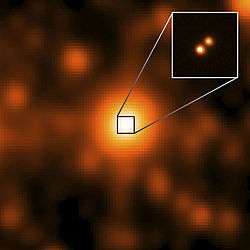Chelyabinsk meteorite
The Chelyabinsk meteorite (Russian:Челябинский метеорит) is the fragmented remains of the large Chelyabinsk meteor of 15 February 2013 which reached the ground after the meteor's passage through the atmosphere. The descent of the meteor, visible as a brilliant superbolide in the morning sky, caused a series of shock waves that shattered windows, damaged approximately 7,200 buildings and left 1,500 people injured.[4][5] The resulting fragments were scattered over a wide area.
| Chelyabinsk | |
|---|---|
 Fragments of the meteorite that were first discovered at Lake Chebarkul. | |
| Type | Ordinary chondrite LL5[1] |
| Shock stage | S4[2] |
| Weathering grade | W0 (pristine) |
| Country | Russia |
| Region | Chelyabinsk Oblast |
| Coordinates | 54.955146°N 60.326614°E |
| Observed fall | Yes |
| Fall date | 15 February 2013, 09:20 YEKT (UTC+06:00) |
| Found date | 27 February 2013 |
| TKW | approximately 1,000 kg (2,200 lb) [3] |
| Strewn field | Yes |
The largest fragment raised from the bottom of Lake Chebarkul on 16 October 2013 had a mass of 540 kg (1,190 lb) [6] and the total mass of other 7 meteorite fragments found nearby was 84.4 kg [6].
Naming
The meteor and meteorite are named after Chelyabinsk Oblast, over which the meteor exploded. An initial proposal was to name the meteorite after Lake Chebarkul, where one of its major fragments impacted and made a 6-metre-wide hole in the frozen lake surface.[7]
Composition and classification
The meteorite has been classified as an LL5 ordinary chondrite. First estimates of its composition indicate about 10% of meteoric iron, as well as olivine and sulfides.[4][8]
Asteroid
The impacting asteroid started to brighten up in the general direction of the Pegasus constellation, close to the East horizon where the Sun was starting to rise.[9] The impactor belonged to the Apollo group of near-Earth asteroids.[9][10]
The asteroid had an approximate size of 18 metres (59 ft) and a mass of about 9,100 metric tons (10,000 short tons) before it entered the denser parts of Earth's atmosphere and started to ablate.[11] At an altitude of about 23.3 km (14.5 miles) the body exploded in an air burst.[11] Meteorite fragments of the body landed on the ground.[12][13]
Analysis of three fragments using optical microscopy, electron microscopy, Raman spectroscopy, and isotopic composition techniques used to date Solar System objects, showed the isotopic clocks in the asteroids (rubidium and strontium ratios, argon isotope ratios) appear to have partially or totally reset in past collisions. The isotopic clock resets may result from thermal effects changing isotopic ratios, and changes to cosmic radiation exposure. The asteroid appears to have had eight major collisions, around 4.53, 4.45, 3.73, 2.81, and 1.46 billion years ago, then at 852, 312, and 27 million years ago.[14][15]
Meteorite
Scientists collected 53 samples nearby a 6-metre-wide hole in the ice of Lake Chebarkul, thought to be the result of a single meteorite fragment impact. The specimens are of various sizes, with the largest being 5 kg (11 lb),[16] and initial laboratory analysis confirmed their meteoric origin.[1]
In June 2013, Russian scientists reported that further investigation by magnetic imaging below the location of the ice hole in Lake Chebarkul has identified a 60-centimetre-large (2 ft) meteorite buried in the mud at the bottom of the lake. An operation to recover it from the lake began on 10 September 2013,[17][18] and concluded on 16 October 2013, with the raising of the rock with the mass of 540 kg (1,190 lb) [6]. It was examined by scientists and handed over to the local authorities,[19][20] who put it on display at the Chelyabinsk State Museum of Local Lore, causing protests from the followers of the recently established "Church of Chelyabinsk Meteorite".[21]
In the aftermath of the superbolide air burst, a large number of small meteorite fragments fell on areas west of Chelyabinsk, including Deputatskoye, generally at terminal velocity, about the speed of a piece of gravel dropped from a skyscraper.[12] Local residents and schoolchildren located and picked up some of the meteorites, many located in snowdrifts, by following a visible hole that had been left in the outer surface of the snow. Speculators became active in the informal market for meteorite fragments that rapidly emerged.[12]
Popular culture
- As of 18 February 2013, some reports surfaced of people trying to sell fake meteorites on the Internet.[22]
- On 15 February (anniversary of the event), during the 2014 Winter Olympics, winners received medals with embedded fragments of the meteorite.[23]
- The "Church of the Chelyabinsk Meteorite" has been set up in the Russian city of Chelyabinsk.[19][24] The founder of the church, Andrey Breyvichko, claims that the large meteorite fragment retrieved from the lake contains a coded "set of moral and legal norms that will help people live at a new stage of spiritual knowledge development".[18] Breyvichko opposes the operation to expose the meteorite fragment in a museum, claiming that only "psychic priests" of his church are qualified to decode and handle the celestial body, which they want to be placed in a temple to be built in Chelyabinsk for the purpose.[18][19][24]
Gallery
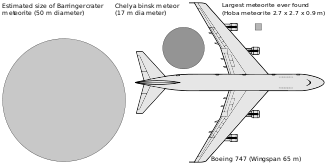 Size comparison of the meteoroid to a Boeing 747, among some other objects
Size comparison of the meteoroid to a Boeing 747, among some other objects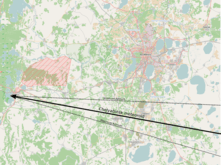 The meteor's path relative to ground
The meteor's path relative to ground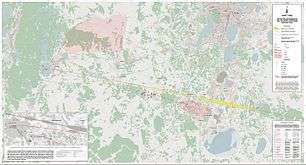 Trajectory projection of Chelyabinsk meteor and strewnfield map of 253 recovered meteorites, of which 199 were weighed and documented (status of 18 Jul 2013).
Trajectory projection of Chelyabinsk meteor and strewnfield map of 253 recovered meteorites, of which 199 were weighed and documented (status of 18 Jul 2013).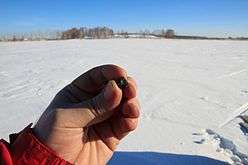 Researcher holds a sample found at Chebarkul lake
Researcher holds a sample found at Chebarkul lake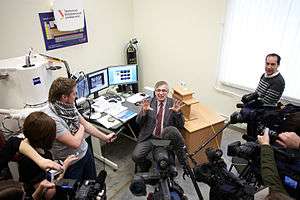 Ural Federal University scientist Victor Grohovsky talks to press during presentation of analysis results in Ekaterinburg
Ural Federal University scientist Victor Grohovsky talks to press during presentation of analysis results in Ekaterinburg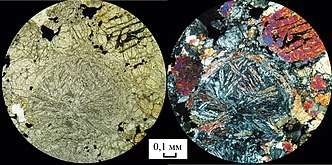 The meteorite under microscopic view (scale: 0.1 mm)
The meteorite under microscopic view (scale: 0.1 mm) Macro photo of a piece of Chebarkul meteorite
Macro photo of a piece of Chebarkul meteorite
References
- "Chelyabinsk". Meteoritical Bulletin Database. The Meteoritical Society. Archived from the original on 2013-06-03.
- "Google Translate" Тип челябинского метеорита оказался уникальным для России - ученые [Chelyabinsk meteorite type was unique for Russia - Scientists] (in Russian). ria.ru. 28 February 2013. Archived from the original on 2013-06-26.
- Kocherov, A.V.; Ivanova, M.A. "Chelyabinsk, recovery of additional masses". Meteoritical Bulletin Database. The Meteoritical Society. Archived from the original on 23 December 2015. Retrieved 23 December 2015.
- "Russische Wissenschaftler finden Teile des Meteoriten" [Russian scientists find parts of the meteorite]. Zeit (in German). 18 February 2013. Archived from the original on 2013-04-20.
- "Meteorite-caused emergency situation regime over in Chelyabinsk region". Russia Beyond The Headlines. Rossiyskaya Gazeta. Interfax. 5 March 2013.
- "45th Lunar and Planetary Science Conference (2014) - Recovery, Laboratory Preparation and Current State of the Main Mass of the Chelyabinsk Meteorite" (PDF). 21 March 2014.
- "Meteorite pulled from Russian lake". BBC News. BBC. 16 October 2013. Archived from the original on 2013-10-16.
- "Russische Wissenschafter fanden Fragmente des Meteoriten" [Russian scientists found fragments of the meteorite]. Standard (in German). 18 February 2013. Archived from the original on 2013-06-23.
- Zuluaga, Jorge I.; Ferrin, Ignacio (2013). "A preliminary reconstruction of the orbit of the Chelyabinsk Meteoroid". arXiv:1302.5377 [astro-ph.EP].
We use this result to classify the meteoroid among the near Earth asteroid families finding that the parent body belonged to the Apollo asteroids.
- de la Fuente Marcos, C.; de la Fuente Marcos, R.; Aarseth, S. J. (10 October 2015). "Chasing the Chelyabinsk asteroid N-body style". The Astrophysical Journal. 812 (1): 26 (22 pp). arXiv:1508.05907. Bibcode:2015ApJ...812...26D. doi:10.1088/0004-637X/812/1/26.
- Yeomans, Don; Chodas, Paul (1 March 2013). "Additional Details on the Large Fireball Event over Russia on Feb. 15, 2013". NASA/JPL Near-Earth Object Program Office. Archived from the original on 2013-04-30.
Note that [the] estimates of total energy, diameter and mass are very approximate.
NASA's web page in turn acknowledges credit for its data and visual diagrams to:- Peter Brown (University of Western Ontario); William Cooke (Marshall Space Flight Center); Paul Chodas, Steve Chesley and Ron Baalke (JPL); Richard Binzel (MIT); and Dan Adamo.
- Kramer, Andrew E. (18 February 2013). "Russians Wade Into the Snow to Seek Treasure From the Sky". New York Times.
- "Meteorite fragments found in Russia's Urals region". BBC News. BBC. 18 February 2013. Archived from the original on 2013-02-19.
- Scharf, Caleb A. "Chelyabinsk Meteor Played 4.5 Billion Years of Cosmic Pinball". Retrieved 2015-10-01.
- Righter, K.; Abell, P.; Agresti, D.; Berger, E. L.; Burton, A. S.; Delaney, J. S.; Fries, M. D.; Gibson, E. K.; Haba, M. K. (2015-09-01). "Mineralogy, petrology, chronology, and exposure history of the Chelyabinsk meteorite and parent body". Meteoritics & Planetary Science. 50 (10): 1790–1819. Bibcode:2015M&PS...50.1790R. doi:10.1111/maps.12511. hdl:2060/20150001932. ISSN 1945-5100.
- Smith, Matt (10 October 2013). "Tough to spot: Chelyabinsk meteor tinted by ancient crashes". CNN. Archived from the original on 2013-10-20.
- "Probable Fragments of Chelyabinsk Meteorite Lifted From Lake". RIA Novosti. 26 September 2013. Archived from the original on 2013-10-17.
- "Like a rock: Church of meteorite set up by worshippers of famous space debris". Russia Today. 17 September 2013. Archived from the original on 2013-09-27.
- "Church of Chelyabinsk Meteorite Founded in Russian Urals". RIA Novosti. 16 September 2013. Archived from the original on 2013-10-17.
- Kocherov, A. V.; Korochantsev, A. V.; Lorenz, C. A.; Ivanova, M. A.; Grokhovsky, V. I. (2014). "Recovery, Laboratory Preparation and Current State of the Main Mass of the Chelyabinsk Meteorite" (PDF). 45th Lunar and Planetary Science Conference (1777): 2227. Bibcode:2014LPI....45.2227K. Archived (PDF) from the original on 2014-02-22.
- "Chelyabinsk asteroid fall anniversary: Sochi champions get meteorite medals". The Voice of Russia. 15 February 2014. Archived from the original on 2014-02-22.
- "Meteorites Found, But Beware Offers to Sell". Space Policy Online. 18 February 2013. Archived from the original on 2013-07-02.
- Whithers, Tom (15 February 2014). "Olympians Win Asteroid-Filled Medals on Russia's Meteorite Anniversary". NBC News. California. Archived from the original on 2014-02-22.
- Faustova, Milena (4 October 2013). "Chelyabinsk meteorite: a message from God?". The Voice of Russia. Archived from the original on 2013-10-04.
External links
| Wikimedia Commons has media related to Chelyabinsk meteorite. |
- "Scientists study 53 tiny meteorites from Russian fireball". Astro Bob. 18 February 2013.
- "Digging for "Chebarkul" meteorites in the snow, new pix plus an orbit". Astro Bob. 23 February 2013.
